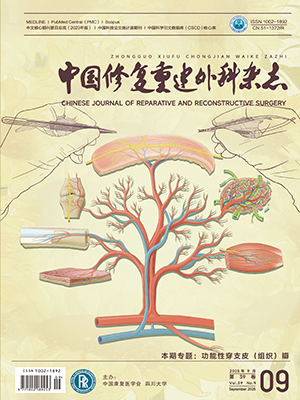Objective To investigate the pathological changes in the neuromuscular junction during ischemiareperfusion(IR) in the skeletal muscle. Methods Forty-eight healthy adult Wistar rats (24 male, 24 female) were equally randomised into the following 6 groups: Group A (control group): no ischemiareperfusion; Group B: ischemia by clamping the blood vessels of the right hindlimb for 3 hours; Group C: ischemia by clamping for 4.5 hours;Group D: ischemia by the clamping for 4.5 hours followed by reperfusion for 1.5hours; Group E: ischemia for 4.5 hours followed by reperfusion for 24 hours; and Group F: ischemia for 4.5 hours followed by reperfusion for 2 weeks. Then, the medial head of the gastrocnemius muscle flap model was applied to the right hindlimb of each rat. The medial head of the gastrocnemius muscle was isolated completely,leaving only the major vascular pedicle, nerve and tendons intact.The proximal and distal ends (tendons) were ligated while the vessel pedicle was clamped. And then, Parameters of the muscle (performance,contraction index,colour,edema,bleeding) were observed. The muscle harvested was stained with gold chloride(AuCl3) and the enzymhistochemistry assay (succinate dehydrogenase combined with acetylcholine esterase) was performed. Morphology and configuration of the neuromuscular junction were observed during the ischemiareperfusion injury by means of the AuCl-3 staining. The result of the enzymhistochemical reactions was quantitatively analyzed with the computer imageanalysis system. And then, additional 5 rats were prepared for 3 different models identical with those in Groups A, C and E separately. The specimens were harvested from each rat and were stained with HE and AuCl-3, and they were examined under the light microscope. Results During the period of ischemia, the skeletal muscle of Group B showed the colour of purple and edema.The colour and edema became worse in Group ,while dysfunction of elasticity and contraction appeared obviously with plenty of dark red hemorrhagic effusion at the same time.After reperfusion,the color and edema of muscle in Group D became improved while the elasticity and function of contraction was not improved. Hemorrhagic effusion of Group D turned clearer and less than Group C.Group E was similar to Group D in these aspects of muscle except for much less hemorrhagic effusion. Skeletal muscle in Group F showed colour of red alternating with white, adhesion,contracture of muscle, exposure of necrotic yellow tissue and almost lost all its functions. The AuCl3 staining showed that during IR, necrosis of the myocytes was followed by degeneration of their neuromuscular junctions, and finally the nerve fibers attached to these neuromuscular junctions were disrupted like the withering of leaves. The enzymhistochemistry assay showed thatthere was no significant difference in the level of acetylcholine esterase between the ischemic group (Groups B and C) and the control group (Group A) (P gt;0.05). However, the level of acetylcholine esterase in all the reperfused groups (Groups D, E and F) decreased significantly when compared with the control group(Group A)and the ischemic groups (Groups B and C) (P lt;0.01). Conclusion The distribution of the nerve fibers and the neuromuscular junctions in the mass of the muscles is almost like the shape of a tree. The neuromuscular junction seems to be more tolerant for ischemia than the myocyte. Survival ofthe neuromuscular junction depends on its myocytes alive. Therefore, an ischemiareperfusion injury will not be controlled unless an extensive debridement of the necrotic muscle is performed.
Citation: WANG Xiaogang,KAN Shilian,ZHANG Baogui,et al.. PATHOLOGICAL CHANGES IN NEUROMUSCULAR JUNCTION DURING ISCHEMIAREPERFUSION IN RAT SKELETAL MUSCLE. Chinese Journal of Reparative and Reconstructive Surgery, 2006, 20(11): 1103-1108. doi: Copy
Copyright © the editorial department of Chinese Journal of Reparative and Reconstructive Surgery of West China Medical Publisher. All rights reserved




